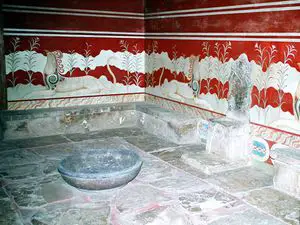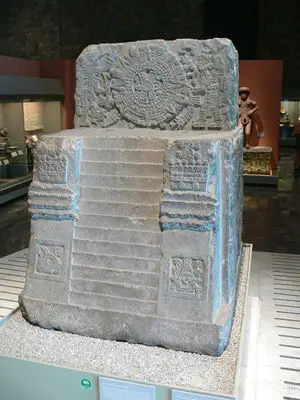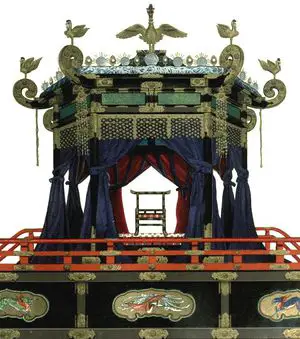How did the Throne Develop as a Royal Symbol
The throne has been a type of royal furniture that has often been associated with the very nature of monarchy. A monarch's authority is often symbolized through the throne and how elaborate or sometimes simple the throne may be has come to symbolize the country in which they rule. While modern government in the West has eschewed monarchy, the throne still retains an important symbolic power that also has religious and other cultural connotations.
Early Thrones and Cultures
From the very first evidence of the establishment of royal authority we begin to see a throne or idea of a raised seat depicted in royal imagery. Both in ancient Egypt and Mesopotamia, depictions of thrones are shown soon after those regions developed royal power. The throne was not just a raised seat but also was placed into a special room, the throne room, where royalty began to receive and meet with foreigners and subjects alike. Thrones were already decorated, often made with ebony, cedar, and gilded with gold or even ivory. Thrones also became raised, to show the status of the king. Often a large stone slab or platform was used to raise the seat. For Egypt, this was particularly important because the king (or pharaoh) was also a god and being raised indicated the divine nature of authority.[1]
For deities, they also became associated as seated figures who resided in special houses (or temples). Sometimes these deities were represented as statues placed in a niche but often they were also represented as seated figures who sat on a throne of authority. In particular, deities associated with monarchs, such as the sun god, were more typically seated, where they would be shown imparting wisdom on rulers to govern their people. This concept is also in the Bible, where Yahweh is described as seated on a throne.[2]
What is telling about thrones is that they were common as soon as regions began to develop the idea of kings and royal authority. Few other pieces of furniture became so common throughout much of the ancient world. In ancient China, chairs were classified and associated with classes of people who could sit on certain chairs. Thrones in China, like many other regions, began to be named, with the latest name used was the Dragon Throne, where the name lasted until the last Qing Dynasty emperor in the early 20th century. In India, the ancient name for the throne was the seat of the lion. Similar to China, it was intricately decorated and was only associated with royal authority.[3]
Europe's oldest throne room is found at the palace of Knossos (Figure 1), a city in Crete that existed in the 2nd millennium BCE. Similar to the ancient Near East, the idea of a throne room was also meant to not only have the raised chair and platform where the king would receive people but wall decorations of griffins, which also became symbols of protection of royal power in the Mediterranean and stretching to Central Asia, began to be prominently displayed. Such mythical symbols continued into modern eras as symbols of protection, often for the state. At Knossos, the throne also was surrounded by benches, which were possibly used by the king's council. Thus, thrones and the throne room also began to symbolize a type of court where council would be given to the king. Later, the idea of a parliament retained this idea, where a king would receive council sitting on a raised throne.[4]
Thrones were also independently used in the New World. Aztec gods, such as Ehecatl, were shown as seated on thrones. An elaborate throne in Tenochtitlan was found, called the throne of Montezuma (Figure 2), which was used for religious and royal ceremony. The Aztec king likely sat on it to perform his religious duties where he made contact with the earth and sun, acting as the sacred guardian of both these important symbols of religious authority.[5][6]
Later Authority
Taking the idea of royal and religious thrones, when Christianity developed it was seen that both high priests, such as bishops or the pope, had authority to sit on thrones as well as kings. In effect, the close nature and symbolism shared between royal and religious power led to similar displays developed in cathedrals, churches, and palaces. European royal thrones, however, developed into more simple designs in contrast to earlier periods or from the royal thrones in Asia (e.g., China or India). Initially in Europe, kings tried to fashion themselves as continuing the traditions of Rome. Royal thrones became more simple as a sign of respect to religious authority and God.[7]
As royal thrones generally became simple in decoration in Europe, religious ones became more elaborate. Bishop thrones in cathedrals or eastern Orthodox thrones, in particular, became gilded with gold and elaborately decorated. The raised platforms, similar to royal thrones, began to symbolize the religious authority figures such as bishops and popes had to teach the masses. In fact, the elaborate nature of thrones became one of the issues that the Reformation decried against.[8]
However, by the later Medieval era, some European states began to not only become more wealthy but the simple thrones and regalia were updated to reflect growing power. One of the more elaborately decorated thrones was that of Ivan the Terrible, who ruled in the 16th century. Ivan was known as a megalomaniac king and lavished his own power greatly. In effect, his throne continued the millennia long tradition of thrones reflecting the type of power royal authorities wanted to display, even when that display shifted from more humble depictions to one of showing more grandeur.[9]
In Asia, thrones continued to be named such as the Peacock throne in Korean, India, and Iran. The throne of Japan is known as the Chrysanthemum Throne (Figure 3). Islamic thrones were often simple, or at least free from pictured art; however, they could contain verses from the Quran. In effect, the ruler was intended to show himself more as a humble servant of God rather than depicted elaborately. In Islam, one of God's great creations is his throne, where it was exalted high above in paradise. In effect, this is similar to Christian, Jewish, and pre-monotheistic concepts of a seated deity. However, now, human thrones had to adjust to become more simplified, as thrones that were too elaborate would suggest worship of a human.[10]
Modern Symbolism
For democratic states that have evolved out of ancient monarchies, the throne still has important meaning to government. In Japan, the Chrysanthemum Throne is described as reflecting the unity and deep history of Japan, as the monarchy in that state is the longest continuing monarchy known to us.[11] In the United Kingdom, the coronation throne, held in Westminster Abbey, looks to be a relatively simple looking chair that the monarch is crowned in. It was once decorated and gilded; however, the aged appearance is part of the symbolism, as it reflects the long continuity of the monarchy. The throne is still used as the symbol of official government power in the UK, where the Queen opens parliament while seated on an elaborate, decorated throne where she is also dressed in her royal jewelry and crown.[12] In Canada, where Queen Elizabeth is still regarded as the Queen of Canada, three thrones are used in the opening of the Senate. In this case, the monarch, her consort, and the speaker sit on the thrones to begin the legislative sessions. In effect, as democratic systems have evolved out of the UK parliamentary system, the idea of a central speaker seated on a raised chair has continued. This is the case in the United States' House of Representatives, where the speaker is seated above the other representatives, symbolically represented as the leader of the legislative body. In the annual state of the union speech, the president is arranged on the front chair, while the speaker of the house is seated in the back and along with the vice-president. This derives from the idea of positioning the monarch along with his/her consort and speaker of the legislative body.[13]
Summary
Thrones have become symbols of royal power and authority but they are also important symbols for the divine and religious authority. The history of thrones shows a connection to some of the earliest written records, indicating that thrones have been a depiction of power from early history. More recently, the concept of a raised chair has continued, where government heads and leaders of legislation sit on a raised position in English speaking modern democracies, demonstrating some continuity with the idea of a raised throne.
References
- ↑ For more on early monarchs and thrones in Egypt and Mesopotamia, see:Houston, M.G. (2002) Ancient Egyptian, Mesopotamian & Persian costume. Mineola, N.Y, Dover Publications.
- ↑ For more on how early gods were depicted as seated figures, see: James B. Pritchard & Daniel E. Fleming (eds.) (2011) The ancient Near East: an anthology of texts and pictures. Princeton, N.J, Princeton University Press.
- ↑ For more on thrones around Asia, see: Stunkel, K.R. (2011) Ideas and art in Asian civilizations: India, China, and Japan. Armonk, N.Y, M.E. Sharpe, Inc.
- ↑ For more on Knossos, see: Castleden, R. (1990) The Knossos labyrinth: a new view of the ‘Palace of Minos’ at Knosos. London ; New York, Routledge.
- ↑ For more on Mayan thrones, see: McKillop, H. (2004) The ancient Maya: new perspectives. ABC-Clio’s understanding ancient civilizations. Santa Barbara,Calif., ABC-CLIO, pg. 220
- ↑ For more on the Aztec thrones, see: Mundy, B.E. (2015) The death of Aztec Tenochtitlan, the life of Mexico City. Joe R. and Teresa Lozano Long series in Latin American and Latino art and culture. Austin, University of Texas Press, pg. 216
- ↑ For more on European thrones in the early Medieval period, see: Collins, R. (2010) Early medieval Europe, 300-1000. History of Europe. 3rd ed. Houndmills, Basingstoke [England] ; New York, NY, Palgrave Macmillan.
- ↑ For more on religious thrones, see: McNamara, D.R. (2009) Catholic church architecture and the spirit of the liturgy. Chicago, Hillenbrand Books.
- ↑ For more on Ivan the Terrible and his throne, see: Payne, P.S.R. & Romanoff, N. (2002) Ivan the Terrible. 1. Cooper Square Press ed. New York, NY, Cooper Square Press.
- ↑ For more on Islam and Islamic rulers, see: Lange, C.R. (2016) Paradise and hell in Islamic traditions. New York, NY, Cambridge University Press.
- ↑ For more on modern Japan and its throne, see: Martin, P. (1997) The chrysanthemum throne: a history of the emperors of Japan. Honolulu, University of Hawai’i Press.
- ↑ For more on the modern throne and government in the UK, see : Lyon, A. (2003) Constitutional history of the UK. London ; Portland, Or, Cavendish Pub, pg. 303.
- ↑ For more on congressional history and its development, see: Julian E. Zelizer (ed.) (2004) The American Congress: the building of democracy. Boston, Houghton Mifflin.


